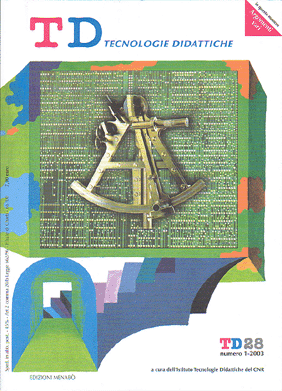Digital technologies and hospital school: activities and scenarios for the future
Main Article Content
Abstract
Article Details
Authors who publish with this journal agree to the following terms:
- Authors retain copyright and grant the journal right of first publication with the work simultaneously licensed under a Creative Commons CC BY 4.0 Attribution 4.0 International License.
- Authors are able to enter into separate, additional contractual arrangements for the non-exclusive distribution of the journal's published version of the work (e.g., post it to an institutional repository or publish it in a book), with an acknowledgement of its initial publication in this journal.
- Authors are permitted and encouraged to post their work online (e.g., in institutional repositories or on their website) prior to and during the submission process, as it can lead to productive exchanges, as well as earlier and greater citation of published work (See The Effect of Open Access)
References
Aiello E. (2001), Progetto Edelweiss: parlano gli insegnanti, Tronconi A. (eds), 7° Convegno Nazionale Informatica Didattica e Disabilità, Roma, pp. 111-114.
Benigno V., Contini M. (2001), Tecnologie dell’informazione e della comunicazione nella scuola in ospedale, Tronconi A. (eds), 7° Convegno Nazionale Informatica Didattica e Disabilità, Roma, pp. 94-99.
Benigno V., Trentin G. (1997), Telematica per la didattica dei bambini e dei ragazzi in ospedale, 5° Convegno Nazionale Informatica, Didattica e Disabilità, pp. 15-18.
Bers M.U. (1999), Building a Society of Self: Zora, a Narrative Graphical Multi-user Environment. In C. M. Hoadley and J. Roschelle (Eds.), Proceedings of the Computer Support for Collaborative Learning (CSCL) 1999 Conference Palo Alto, CA: Stanford University, pp. 33-40.
Brown A. L., Rutherford M., Nakgawa K., Gordon A., Campione J. (1993), Distribuited Expertise in the Classroom, G. Salomon (eds) Distribuited Cognition, Cambridge University Press, New York, pp. 188-228.
Chioccariello A. (2000), Il computer nella scuola dell’infanzia, TD Tecnologie Didattiche, vol. 20, n. 2, pp. 36-43.
Chioccariello A., Manca S., Sarti L. (2002), La fabbrica dei robot, TD Tecnologie Didattiche, vol. 27,n. 3, pp. 56-67.
Manca S., Trentin G. (1996), DeskTop Conferencing e Didattica Collaborativa, Trentin G. (eds), Didattica in rete, Garamond, Roma.
Perkins D. N.(1991), Technology meets constructvism: Do you make a marriage? Educational Technology, vol. 31, n. 5, pp.18-23.
Riel M. (1994), Comunità d’apprendimento, Tecnologie Didattiche, vol. 2, pp.18-29.
Salomon G. (1996), Studying Novel Learning Environments as Patterns of change, in S. Vosniadou (eds), Intenational Perspective on the Design of Techonology-Supported Leraning Environments, Erlbaum, Mahwah, pp. 363-377.
Slavin S.R. (1995), Cooperative Learning. Theory, research and practice. MA: Allyn& Bacon, Boston, 2nd ed.
Sharan S. (1990), Cooperative Learning: Theory and research, Praeger, New York.
Trentin G., Benigno V. (1998), Telematics for the Schooling of Hospitalised Children: An Italian Survey, Journal of Online Learning, vol. 9, n 4, pp. 17-21.
Wilson B.G. (1996a), What is a Contructivist Leraning Environment? Wilson B.G. (eds), Contructivist Leraning Environments, Educational Technology Pubblications, Englewood Cliff, pp. 3-8
Wilson B.G. (1996b): Metaphors for instruction: why we talk about learning environments, http://carbon.cudenver.edu/ ~bwilson/metaphor.html
Wood D., Bruner J., Ross G. (1976), The role of tutoring in problem solving, Journal of child Psychology and Psychiatry, 17, pp. 89-100.

